Is It Safe to Eat Bay Leaves
Bay leaves are safe to eat when used properly in cooking, but you shouldn't consume them whole. These aromatic leaves add flavor to dishes but can pose a choking hazard if ingested intact. Always remove bay leaves before serving, as their tough texture and sharp edges can cause injury. When used correctly, bay leaves offer minimal calories and potential health benefits due to their antioxidant properties. You can safely enjoy their flavor by using whole leaves in a bouquet garni or tea infuser during cooking, then discarding them. If you're concerned about safety, consider using ground bay leaves or alternative herbs. Exploring proper handling techniques can enhance your culinary experience while ensuring safety.
This post may contain affiliate links. If you make a purchase through these links, I may earn a commission at no additional cost to you. Additionally, portions of this post may be generated using artificial intelligence (AI) technology. While we strive for accuracy, please be aware that AI-generated content may not always be perfect and should be fact-checked when necessary.
The Spatula Scoops
- Bay leaves are safe to use in cooking but should be removed before serving to prevent choking hazards.
- Consuming whole bay leaves can cause injuries to the mouth or digestive tract due to their tough texture and sharp edges.
- Bay leaves are not toxic, but their safety concerns stem from physical risks rather than chemical toxicity.
- Ground or infused bay leaves can be safely consumed, eliminating the choking risk associated with whole leaves.
- Bay leaves offer potential health benefits, including antioxidant properties, with minimal caloric impact when used in cooking.
Understanding Bay Leaves
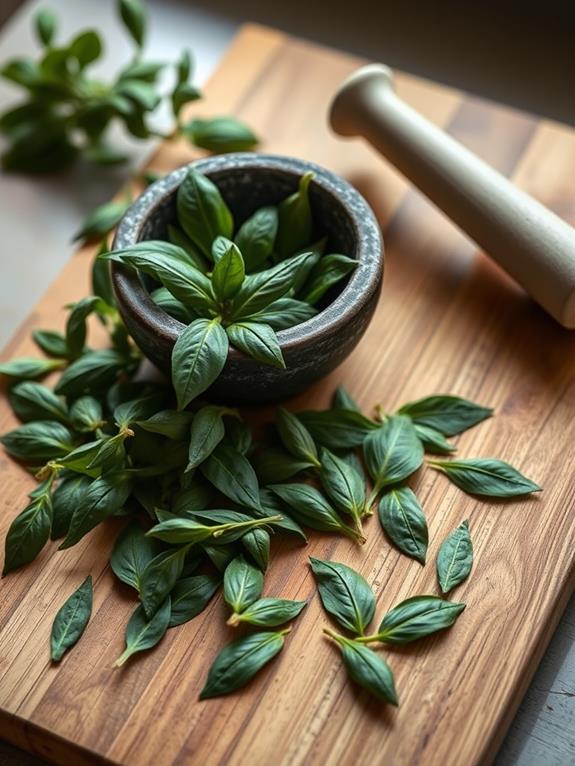
Understanding Bay Leaves
Two key aspects of bay leaves are important to understand: their culinary use and potential risks. Bay leaves, derived from the Laurus nobilis tree, are a popular flavoring agent in many cuisines. You'll often find them in soups, stews, and other slow-cooked dishes. Their distinct aroma and flavor enhance the overall taste of your meals. Additionally, bay leaves can provide various health benefits, as they are rich in antioxidants and may support digestive health, similar to the benefits found in other plant-based ingredients like hemp milk.
However, it's vital to recognize that while bay leaves are safe for cooking, they're not meant to be eaten whole. A whole bay leaf poses a significant choking hazard due to its rigid texture, which doesn't soften even after prolonged cooking. This rigidity also makes them difficult to digest if accidentally swallowed.
When using bay leaves in your cooking, always remember to remove them before serving. They're excellent for infusing flavor, but you should treat them as a temporary ingredient. It's also important to use culinary-grade bay leaves, as some laurel varieties can be toxic. If you're foraging or using leaves from an unfamiliar source, exercise caution and verify their safety before incorporating them into your dishes.
Culinary Uses and Benefits
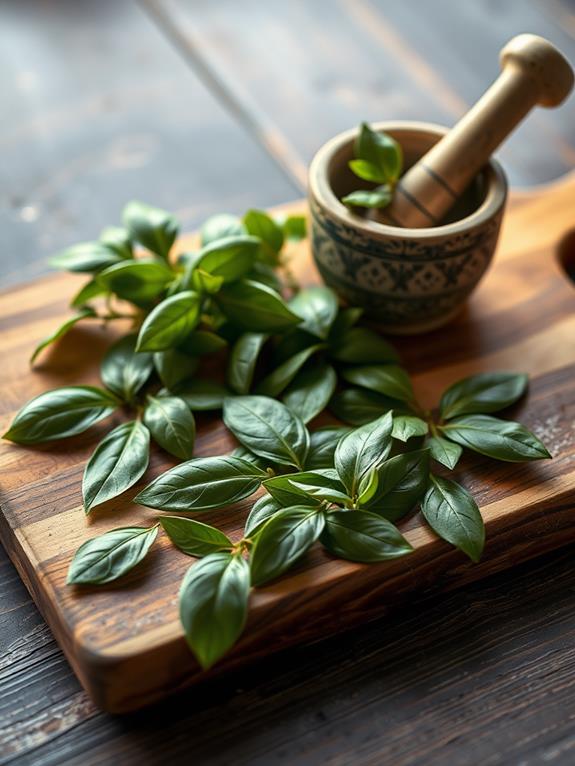
Having established the basics of bay leaves, let's explore their culinary applications and advantages. You'll find bay leaves commonly used in slow-cooked dishes like soups, stews, and braises. They impart a rich, herbal flavor that enhances the overall taste of your meal. Additionally, cooking with cast iron cookware, like the Lodge 10.25-Inch Pre-Seasoned Cast Iron Skillet, can further enhance the depth of flavors in your dishes. However, it's essential to remember that bay leaves have an indigestible texture and can pose choking hazards if swallowed whole.
When using bay leaves in your cooking, you'll typically add them whole to your dish and remove them before serving. This traditional method allows for easy tracking and extraction. If you're using fresh bay leaves, you'll notice a more intense flavor compared to their dried counterparts. Dried bay leaves, on the other hand, become more potent after the drying process and can be stored for one to three years.
To simplify the flavoring process and guarantee easy removal, you can employ techniques like using a bouquet garni or a tea infuser. These methods allow you to infuse your dishes with the bay leaf's flavor while minimizing the risk of accidentally consuming the leaf itself.
Safety Concerns and Risks
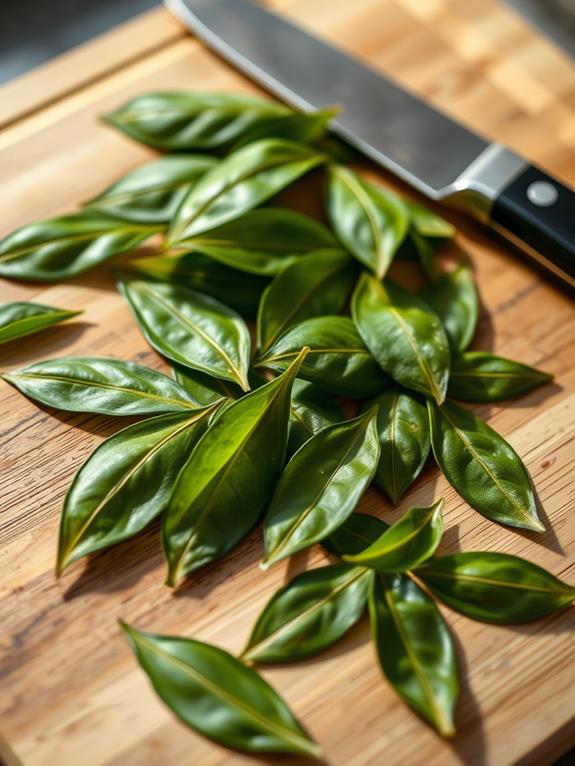
While bay leaves are widely used in cooking, it's vital to understand their potential safety risks. You might not realize it, but consuming whole bay leaves can pose serious choking hazards. Their tough texture and sharp edges can cause injury to your mouth, esophagus, or digestive system if swallowed. In addition, similar to how buttermilk adds tanginess to recipes, the robust flavor of bay leaves is meant to enhance dishes rather than be ingested whole.
Medical literature has documented cases of bay leaf impaction in the esophagus, highlighting the importance of removing these leaves before serving your dishes. This risk is particularly concerning for young children and individuals with swallowing difficulties. To minimize these dangers, you can opt for grinding bay leaves or using them in a tea infuser, allowing you to enjoy their flavor safely.
While bay leaves offer culinary benefits, it's important to exercise caution. Remember, they're meant to flavor your food, not to be eaten whole. By being mindful of these safety concerns, you can continue to use bay leaves in your cooking without putting yourself or your loved ones at risk. Always remove whole bay leaves from your dishes before serving, and consider alternative methods like grinding to incorporate their flavor more safely.
Proper Handling in Cooking
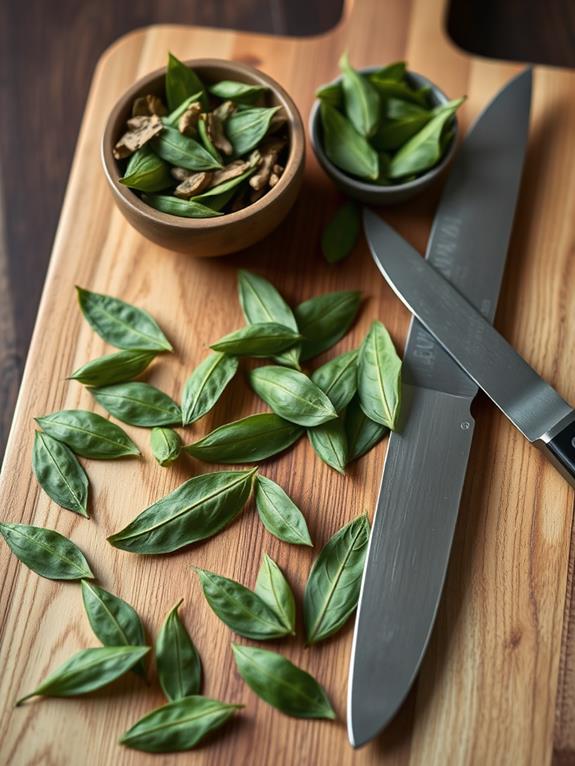
For safe and effective use of bay leaves in cooking, proper handling is essential. You'll want to remember that bay leaves are indigestible and can pose choking risks if consumed directly. Always use whole leaves in your dishes, and be certain to remove them before serving. This practice prevents potential injuries from their sharp edges and guarantees a pleasant dining experience.
To simplify the removal process, consider using a tea infuser or bouquet garni technique. These methods allow for flavor extraction while containing the leaves. When adding bay leaves to your recipes, start with one or two to gauge the desired intensity before adding more.
Here's a quick reference table for proper bay leaf handling:
| Do's | Don'ts | Safety Tips |
|---|---|---|
| Use whole leaves | Chop or crumble | Count leaves used |
| Remove before serving | Leave in dishes | Use tea infuser |
| Start with 1-2 leaves | Overuse | Inform diners |
| Use bouquet garni | Serve directly | Check before serving |
| Adjust to taste | Ignore removal | Store properly |
Nutritional Value of Bay Leaves
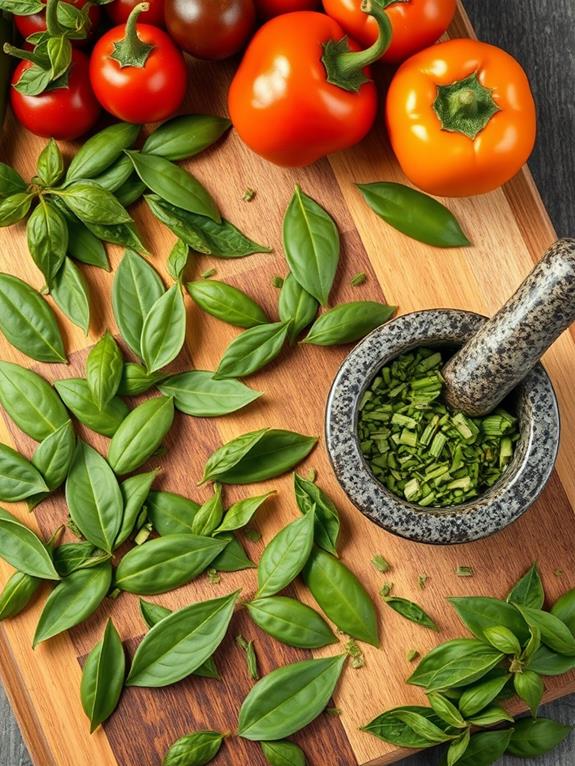
When you're considering the nutritional value of bay leaves, you'll find they're not a significant source of essential nutrients. Their caloric content is negligible, with each leaf containing about one calorie, making them a virtually zero-calorie addition to your dishes. While bay leaves contain some antioxidants and compounds that may have anti-inflammatory properties, these potential benefits are still being researched and aren't well-established in scientific literature.
Essential Nutrients in Bay
Despite their widespread use in cooking, bay leaves aren't known for their nutritional value. They're incredibly low in calories and contain minimal macronutrients, which means they won't contribute notably to your daily energy intake. However, bay leaves do possess some essential nutrients that can enhance your diet in subtle ways.
One of the key components of bay leaves is their essential oils. These oils contain compounds like eugenol, which may offer antioxidant and anti-inflammatory benefits. While more research is needed to confirm these effects, the presence of antioxidants in bay leaves suggests potential health advantages, such as improved digestion and reduced inflammation.
You'll also find trace amounts of minerals in bay leaves, including calcium, magnesium, and iron. While these quantities are small, they can contribute to your overall mineral intake when combined with other nutrient-dense foods in your diet. It's essential to observe that while bay leaves offer some nutritional benefits, they shouldn't be relied upon as a primary source of essential nutrients. Instead, consider them a flavorful addition to a well-balanced diet, complementing other nutrient-rich ingredients in your meals.
Antioxidant Properties Explored
While bay leaves may not be a nutritional powerhouse, their antioxidant properties make them a valuable addition to your diet. These leaves contain essential oils that exhibit notable antioxidant properties, which can help neutralize free radicals in your body. By doing so, they potentially reduce oxidative stress, a factor linked to various health issues.
Research has demonstrated the antioxidant activity of bay leaf extracts, highlighting their ability to scavenge harmful compounds. This means that when you incorporate bay leaves into your meals, you're introducing beneficial phytochemicals, including flavonoids and phenolics, which contribute to the leaves' health-promoting characteristics.
What's more, the essential oils derived from bay leaves have shown significant potential in exhibiting anti-cancer effects, particularly in certain cancer models like breast cancer. While more research is needed, these findings underscore the leaves' potential health benefits.
Caloric Content Analysis
From a caloric perspective, bay leaves are a dieter's dream. These aromatic leaves pack a flavorful punch without adding significant calories to your meals. A single dried bay leaf contains approximately 1 calorie, making it a negligible contributor to your daily caloric intake. Even when you use multiple leaves in a recipe, the caloric content remains minimal.
Bay leaves are typically used whole in cooking and removed before serving, further reducing their already low caloric impact. While they don't provide substantial macronutrients, they do offer trace amounts of vitamins A, C, and some B vitamins. The primary composition of bay leaves consists of essential oils, which are responsible for their distinctive aroma and flavor rather than nutritional value.
If you're counting calories, you'll be pleased to know that even a tablespoon of crushed dried bay leaves only amounts to about 5 calories. This means you can enhance your dishes with the rich, savory notes of bay leaves without worrying about derailing your diet. Their minimal caloric content, combined with their ability to add depth to a wide range of recipes, makes bay leaves a smart choice for health-conscious cooks.
Alternatives and Substitutes
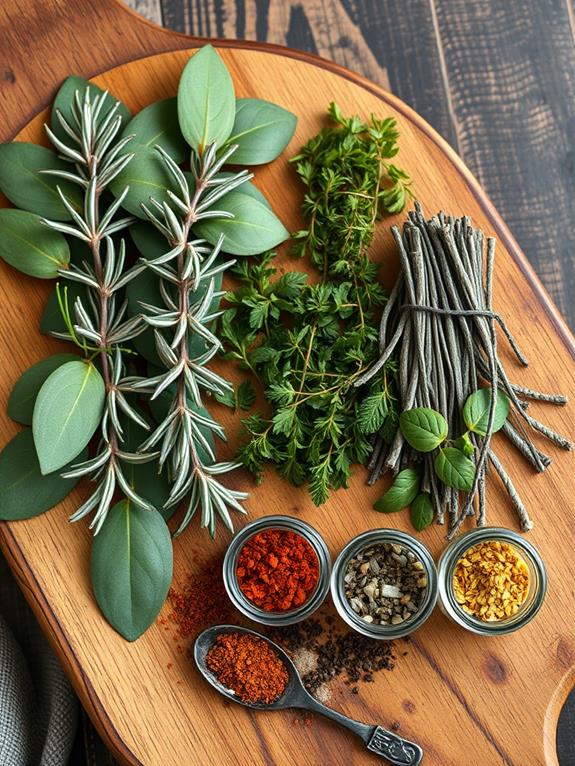
If you're looking to replace bay leaves in your cooking, you've got plenty of options. You can try other aromatic herbs like thyme, oregano, or basil, which offer similar flavor profiles. For those concerned about texture, consider using a bouquet garni with fresh herb sprigs, or experiment with whole spices like fennel seeds or allspice berries for long-cooking dishes.
Common Bay Leaf Replacements
Searching for bay leaf substitutes can open up a world of flavoring possibilities in your kitchen. Common substitutes for bay leaves include dried herbs like basil, thyme, oregano, and rosemary. These alternatives can provide similar herbal complexity to your dishes, though they won't perfectly replicate the unique flavor of bay leaves.
When using dried herbs as replacements, remember that they're more concentrated in flavor. You'll typically need only 1-2 teaspoons of dried herbs to substitute for a fresh bay leaf. For a more traditional approach, consider creating a bouquet garni with parsley and other herbs. This method mimics the aromatic qualities of bay leaves while ensuring easy removal after cooking.
If you're feeling adventurous, try using celery leaves or kaffir lime leaves for a unique twist. These alternatives impart different yet complementary flavors to various dishes. As you experiment with substitutions, keep in mind that the taste won't be identical to bay leaves. It's advisable to adjust quantities based on your personal preferences and the specific recipe you're preparing. Always taste as you go to achieve the desired flavor profile in your culinary creations.
Herb Combinations for Flavor
Culinary creativity flourishes when you explore herb combinations as alternatives to bay leaves. By mixing different herbs and spices, you'll discover new flavor profiles that can enhance your dishes in unique ways. Some commonly used herb combinations include:
- Thyme and oregano for a Mediterranean-inspired blend
- Basil and oregano for an Italian flavor profile
- Thyme and rosemary for a robust, earthy taste
- Parsley and tarragon for a fresh, slightly anise-like flavor
These pairings offer possible uses in various recipes, from soups and stews to marinades and sauces. When substituting for bay leaves, consider the dish's overall flavor profile and cooking method. For slow-cooked dishes, thyme and oregano work well together, providing a complex taste that develops over time. In fresh preparations, basil and parsley can offer a bright, aromatic alternative.
Remember that herb combinations can be more potent than single herbs, so start with smaller amounts and adjust to taste. Experimenting with different ratios and combinations will help you find the perfect blend for your culinary creations. By understanding the unique characteristics of each herb, you'll be able to create flavorful alternatives that suit your palate and complement your dishes effectively.
Non-Herb Flavor Enhancers
Versatility in the kitchen extends beyond herbs when seeking alternatives to bay leaves. You'll find that citrus peels or dried lemon zest can provide a bright, fragrant note similar to the herbal qualities of bay leaves. When substituting, remember that a little goes a long way – start with a small piece of peel or just a pinch of zest.
If you're looking for a quick substitute, don't hesitate to simply omit bay leaves from your recipe. Many dishes can maintain their flavor balance through other ingredients like onions, garlic, or a splash of vinegar for acidity. These non-herb flavor enhancers can effectively replicate the aromatic qualities you're after.
It's important to note that while these substitutes can enhance your dish's flavor profile, they don't carry the same risks associated with bay leaf consumption. However, always consult medical advice if you have concerns about specific ingredients. When experimenting with substitutes, remember that fresh ingredients are generally more potent than dried ones. As a rule of thumb, use three times the amount of fresh substitutes compared to dried ones for peak flavor in your culinary creations.
Myths vs. Facts
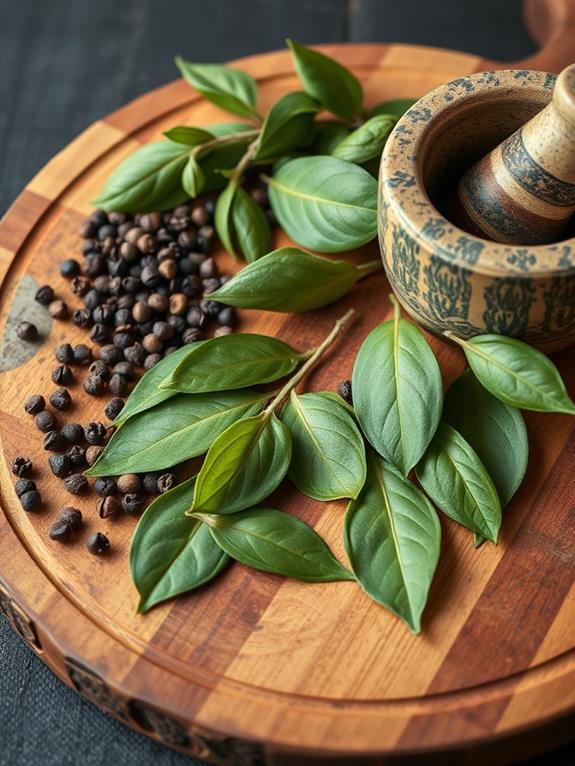
Numerous myths surround the safety of bay leaves, often leading to confusion among home cooks. You may have heard that bay leaves are toxic or as dangerous as swallowing glass, but these claims are exaggerated. The truth is, bay leaves aren't poisonous, but they do pose potential risks if consumed whole.
The main concerns with bay leaves are:
- Choking hazards due to their rigid texture
- Potential injury to the mouth or digestive tract from sharp edges
- Indigestibility, which can cause digestive discomfort
- Unpleasant texture when eaten directly
While bay leaves enhance the flavor of your dishes, they're not meant to be eaten whole. Their indigestible nature and tough texture make them a choking risk if swallowed. It's essential to remove bay leaves before serving your meals to guarantee safety.
You can safely use bay leaves in your cooking by following proper practices. Consider using a bouquet garni or tea infuser for easy removal. Remember, the primary concern isn't toxicity but the physical risks associated with consuming whole bay leaves. By understanding these facts, you can confidently use bay leaves to elevate your culinary creations while prioritizing safety.
Frequently Asked Questions
Why Do They Say Not to Eat Bay Leaves?
Ever wondered why chefs aren't handing out bay leaf lollipops? Well, they're not trying to hoard all the leafy goodness. You're advised not to eat bay leaves because they're tough and indigestible, even after cooking. They can pose a choking hazard or cause injury if swallowed whole. Their sharp edges might damage your throat or digestive tract. Plus, they're not exactly a culinary delight when eaten alone. It's best to use them for flavor and remove them before serving.
Can You Eat a Bay Leaf if Blended?
While blending bay leaves might seem like a solution, it's not entirely safe. You'll still face potential risks because blended bay leaves retain their tough, fibrous texture. Even in powdered form, they can cause digestive discomfort and pose a choking hazard. It's better to use pre-ground bay leaves in your cooking. They're safer and easier to incorporate into dishes without the need for removal. Remember, though, that ground bay leaves are more concentrated, so use them sparingly to avoid overpowering your meal.
Are Bay Leaves Healthy to Eat?
Imagine you're cooking a hearty stew and wondering about those bay leaves. While they're packed with potential health benefits, including antimicrobial properties and possible blood sugar regulation, it's not recommended to eat them directly. You'll get the most benefit from bay leaves by using them to flavor your dishes, then removing them before serving. They're tough and indigestible, posing choking and digestive risks. So, enjoy their aromatic flavors in your cooking, but don't consume them whole.
Is It Safe to Cook With Fresh Bay Leaves?
Yes, it's safe to cook with fresh bay leaves. You'll find they add a robust, aromatic flavor to your dishes, especially soups and stews. However, remember to remove them before serving, as they can be a choking hazard. Start with one or two leaves, as they're more potent than dried ones. Incorporate them during cooking to infuse flavors, but always discard them before eating. Proper storage is key to maintaining their quality, as fresh bay leaves have a shorter shelf life.





